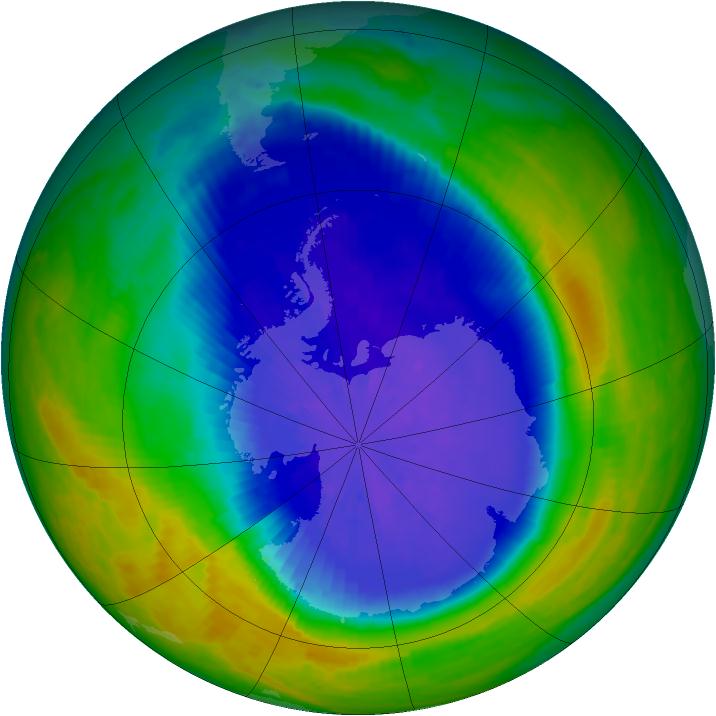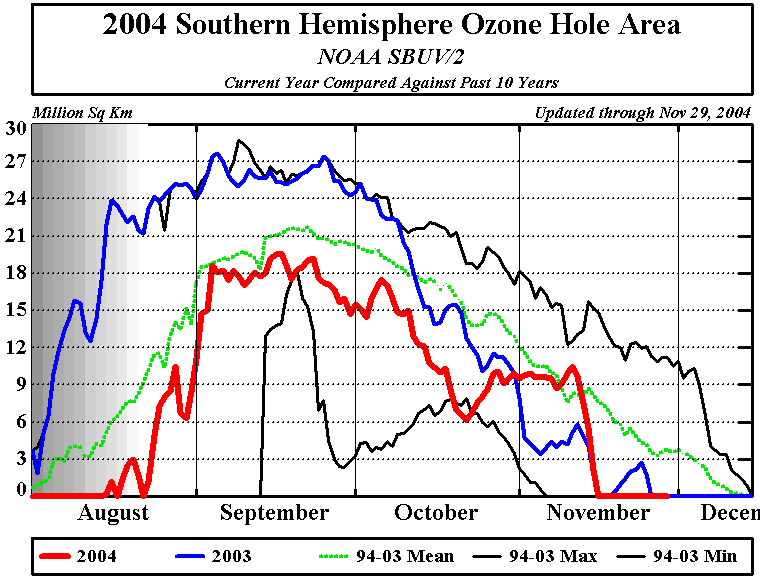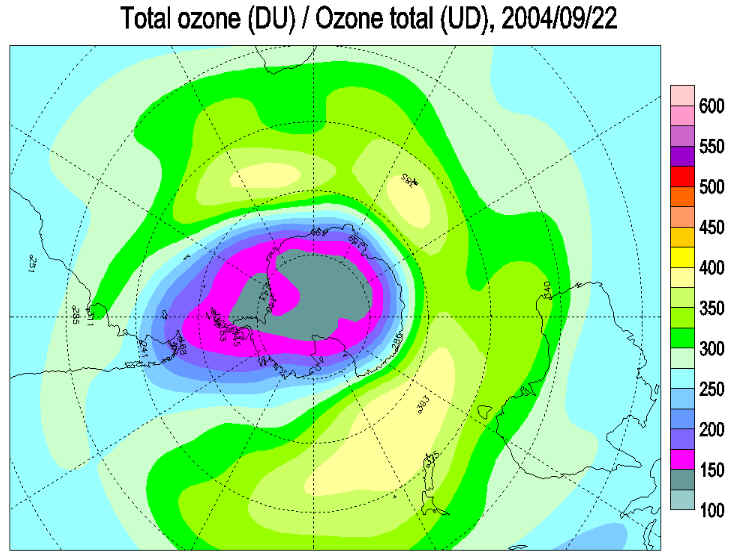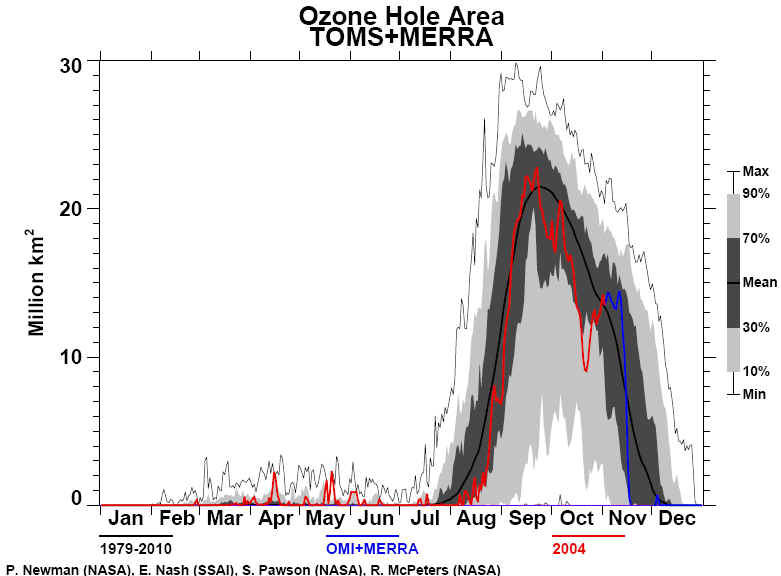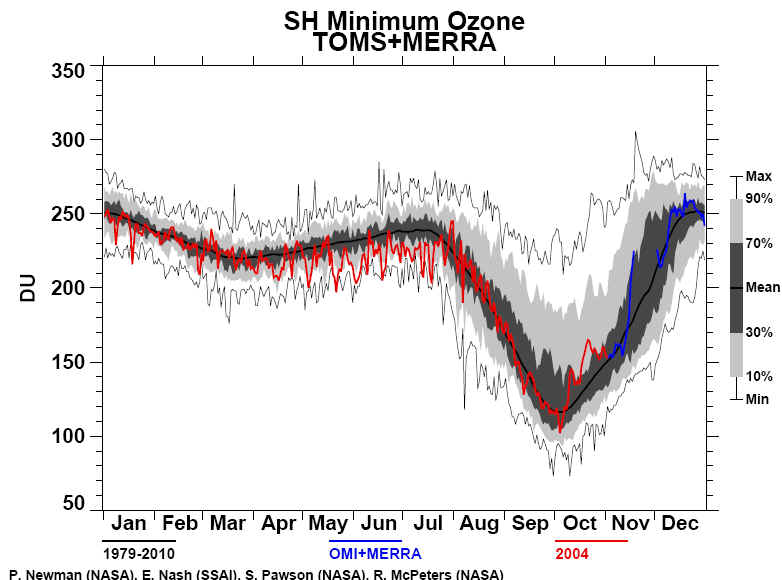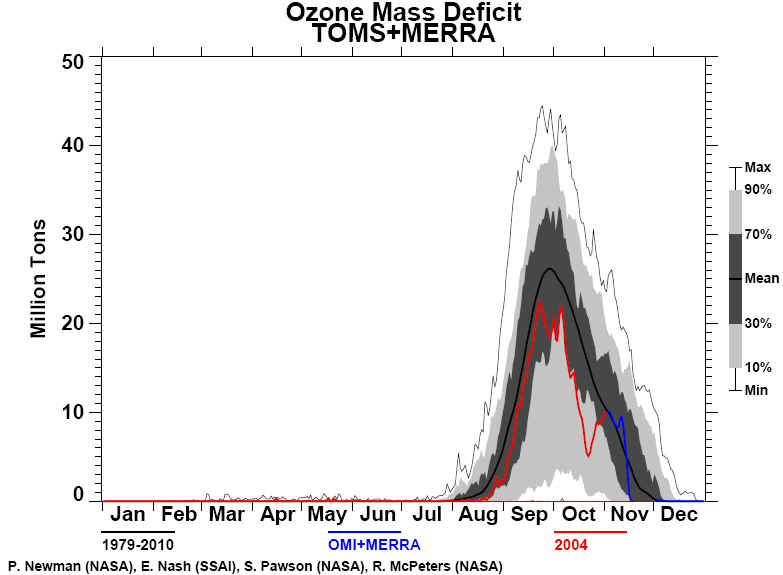|
Ozone Hole 2004
http://ozonewatch.gsfc.nasa.gov
http://www.cpc.ncep.noaa.gov/products/stratosphere/sbuv2to/ozone_hole.html
2004
Antarctic Ozone Hole
10.12.04 NASA
Antarctic ozone hole – smaller this year 1 October 2004 The ozone hole over Antarctica appears to be about 20% smaller than last year’s record-breaking ozone hole. Measurements by NIWA, supported by Antarctica New Zealand, at Scott Base, Antarctica, are consistent with NASA satellite data showing the area of the hole peaked at about 24 million square kilometres, compared to 29 million square kilometres in 2003. “Measurements from the ground at Scott Base suggest that there is slightly more ozone this year than the average for recent years,” says NIWA atmospheric scientist Dr Stephen Wood. “But ozone levels are still lower than before the ozone hole started forming in the early 1980s.” “The first spring measurements of ozone from Scott Base this year showed levels at around 200 Dobson Units (DU) but have been as low as 165 DU in the past week. Satellite measurements are reporting values as low as 110 DU in some parts of the hole. Before the early 1980s, ozone levels in Antarctica never went below 220 DU.” The ozone hole is the result of a combination of factors: man-made chemicals containing chlorine and bromine; the isolation and cold of the Antarctic atmosphere during the polar winter; the formation of polar stratospheric clouds; the chemical reactions that occur on the surfaces of those clouds; and the return of sunlight in spring. Although the man-made chemicals that contribute to ozone depletion are already starting to decline in the atmosphere (thanks to controls on their use under the Montreal Protocol), some of the other factors vary from year to year. Because of this natural variation, Dr Wood cautions against reading too much into the smaller size of the hole this year. “We need to see smaller or less severe ozone holes over a number of years before we can say for certain that ozone is recovering,” he says. At present, the ozone-depleted air is well contained over Antarctica. The only inhabited area it could affect at the moment is the extreme tip of South America. But Dr Wood says the hole will indirectly affect New Zealand later in the year. “When the ozone hole breaks up in November or early December, ozone-depleted air moves into surrounding areas in the southern hemisphere, including New Zealand. The later the ozone hole breaks up, the higher the sun is in the sky over New Zealand and the larger the effect on UV levels. If New Zealand experiences a combination of lower ozone with high sun and few clouds, then skin-damaging UV levels can be extreme.” Research conducted at NIWA’s atmospheric research facility at Lauder, Central Otago, shows that approximately half the long-term ozone decline at mid-latitudes in the southern hemisphere (including New Zealand) has been caused by the export of ozone-depleted air from Antarctica. In recent years, there has been about ten percent less ozone over New Zealand in the summer than 30 years ago. NIWA’s measurements of ozone near Scott Base are part of research funded by the Foundation for Research Science and Technology to understand what drives global change in the atmosphere. The ground-based measurements are also important for validating measurements taken from satellites. Situation at 2004 August 19-British Antarctic Survey Ozone BulletinThe ozone layer over Antarctica is in the normal winter circulation pattern, however ozone depletion has begun at the edge of the circumpolar vortex. Ozone values are generally slightly higher around Antarctica, with lower values over the continent. Some areas are already below 200 DU (a frequent measure of ozone hole conditions) with depletions of above 35%. So far, the area over Antarctica with conditions suitable for ozone depletion is smaller than in 2003. 2004 September 1 Envisat witnesses return of the South Polar ozone hole Situation at 2004 September 6-British Antarctic Survey Ozone BulletinThe ozone hole (where ozone values are below 220 DU) has grown rapidly over the last fortnight and now covers nearly 15 million square kilometres. The lowest ozone values are over the Weddell Sea and here values are 40% below normal. Ozone values are higher in a broad band between 60°S and 30°S, in places exceeding 400 DU. Situation at 2004 September 6-British Antarctic Survey Ozone Bulletin The ozone hole (where ozone values are below 220 DU) has grown rapidly over the last fortnight and now covers nearly 18 million square kilometres, about average over the last decade. The lowest ozone values are over the Weddell Sea and here values are 40% below normal. Ozone values are higher in a broad band between 60°S and 30°S, in places exceeding 400 DU. The edges of the ozone hole are expected to pass over the southern tip of South America, the Falkland Islands and South Georgia from September 10 to 12. Situation at 2004 September 16-British Antarctic Survey Ozone BulletinThe ozone hole (where ozone values are below 220 DU) grew rapidly from mid August to early September and covers around 18 million square kilometres, about average over the last decade. It has remained at a similar size for the last ten days. The lowest ozone values are over the southern Weddell Sea and Ronne Ice Shelf, and here values are nearly 50% below normal. Ozone values are higher in a broad band between 60°S and 30°S, in places exceeding 400 DU. The edge of the ozone hole passed over the southern tip of South America, the Falkland Islands and South Georgia from September 10 to 12. It is expected to do so again from September 19 to 22, with larger ozone depletion possible from September 21 to 22. Situation at 2004 September 21-British Antarctic Survey Ozone Bulletin The ozone hole (where ozone values are below 220 DU) grew rapidly from mid August to early September and covers around 20 million square kilometres, about average over the last decade. It has only increased a little in area over the last fortnight. The lowest ozone values are over the southern Antarctic Peninsula and off Enderby Land, and here values are over 40% below normal. Ozone values are higher in a broad band between 60°S and 30°S, in places exceeding 400 DU. The edge of the ozone hole passed over the southern tip of South America, the Falkland Islands and South Georgia from September 10 to 12. It is expected to do so again from September 19 to 24, with larger ozone depletion possible from September 21 to 23, possibly affecting regions as far north as 40°S. Note: The ozone hole is usually largest in early September and deepest in late September to early October. September 16 was world ozone day. Prior to the formation of ozone holes, ozone values were normally at their lowest in the autumn (ie March). September 22- Ozone Hole Reaches South America The edge of the ozone hole is over the southern tip of South America, the Falkland Islands and South Georgia Situation at 2004 October1-British Antarctic Survey Ozone Bulletin The ozone hole (where ozone values are below 220 DU) grew rapidly from mid August to early September to reach around 19 million square kilometres. It has remained at a roughly similar area for most of September, which is a little below the average over the last decade. The lowest ozone values are over the southern Weddell Sea, and here values are around 50% below normal. Ozone values are higher in a broad band between 60°S and 30°S, in places over 400 DU. The edge of the ozone hole passed over the southern tip of South America, the Falkland Islands and South Georgia from September 10 to 12. It did so again between September 18 and October 2, with ozone hole levels over southern South America and the Falkland Islands on September 21 and 22. Ozone values remain low over South Georgia and are likely to remain so until October 3. Ozone values are again likely to be low over southern South America, the Falkland Islands and South Georgia between October 5 and 7, when there are signs of a stratospheric spring warming on the opposite side of the continent. Situation at 2004 October 1 and outlook to October 15 British Antarctic Survey Ozone Bulletin The ozone hole (where ozone values are below 220 DU) grew rapidly from mid August to early September to reach around 19 million square kilometres. It has remained at a roughly similar area for most of September, which is a little below the average over the last decade. The lowest ozone values are over the southern Weddell Sea, and here values are around 50% below normal. Ozone values are higher in a broad band between 60°S and 30°S, in places over 400 DU. The edge of the ozone hole passed over the southern tip of South America, the Falkland Islands and South Georgia from September 10 to 12. It did so again between September 18 and October 2, with ozone hole levels over southern South America and the Falkland Islands on September 21 and 22. Ozone values are again likely to be low over southern South America, the Falkland Islands and South Georgia between October 11 and 15, when there are signs of a stratospheric spring warming on the opposite side of the continent.
Situation at 2004 November 16-British Antarctic Survey Ozone Bulletin The ozone hole (where ozone values are below 220 DU) grew rapidly from mid August to early September to reach around 19 million square kilometres. It slowly decreased in area from a maximum of 20 million square kilometres in mid September to 15 million square kilometres in early October. A major spring warming commenced in mid October, when the area declined rather more rapidly to 6 million square kilometres. However, the warming subsided and the area affected slowly declined from around 10 million square kilometres in late October to around 8 million square kilometres in mid November. The area of the hole has generally been a little below the average size of the last decade. Currently, the lowest ozone values, below 170 DU, are over West Antarctica, and in some places values are around 50% below normal. Ozone values are higher in a broad band between 60°S and 30°S, in places above 370 DU. The edge of the ozone hole passed over the southern tip of South America, the Falkland Islands and South Georgia from September 10 to 12. It did so again from September 18 to October 2, and October 11 to 15, with ozone hole levels over southern South America and the Falkland Islands on September 21 and 22. Values were also low over South Georgia on October 7 and 8. Current stratospheric analyses and forecasts suggest that the final warming has commenced, with ozone values and temperatures generally rising, although it is likely that a remnant of the ozone hole will persist of another week. Situation at 2004 December 13-British Antarctic Survey Ozone Bulletin The 2004 Antarctic ozone hole season is now over, with the circulation over the continent in its summer mode. The ozone layer over much of the Southern Hemisphere south of 50° remains around 10% below the long term normal. The ozone hole (where ozone values are below 220 DU) grew rapidly from mid August to early September to reach around 19 million square kilometres. It slowly decreased in area from a maximum of 20 million square kilometres in mid September to 15 million square kilometres in early October. A major spring warming commenced in mid October, when the area declined rather more rapidly to 6 million square kilometres. However, the warming subsided and the area affected slowly declined from around 10 million square kilometres in late October to around 8 million square kilometres in mid November. The ozone hole area rapidly dropped to zero after mid November. The area of the hole was generally a little below the average size of the last decade. The edge of the ozone hole passed over the southern tip of South America, the Falkland Islands and South Georgia from September 10 to 12. It did so again from September 18 to October 2, and October 11 to 15, with ozone hole levels over southern South America and the Falkland Islands on September 21 and 22. Values were also low over South Georgia on October 7 and 8. In the Northern Hemisphere there is currently significant ozone depletion over the Arctic Ocean.
|
|||||||||||||||||||||||||

